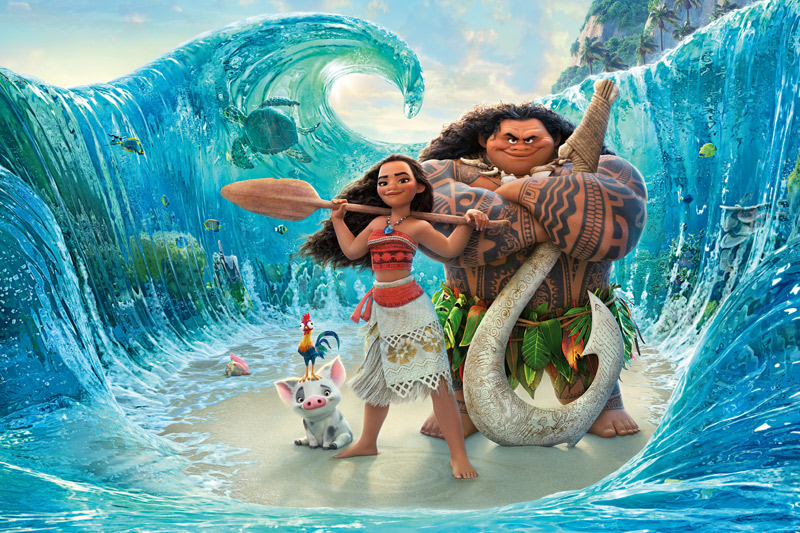The following contains spoilers for Disney’s newest movie, Moana. Go see it!

Last week, I finally went to see Disney’s Moana, after hearing so many people gush about it for months. While I enjoyed the story, and especially loved the musical score, what struck me most was the emphasis on sailing and navigation throughout the movie. Ever the scholar, I decided to do more research into the nautical history of the Polynesian cultures from which Moana draws inspiration.
The historical basis for the movie is the “Long Pause”, an approximately 2,000-year hiatus in Polynesian voyaging. While settlement of Western Polynesia dates to around 3,500 years ago, the Central and Eastern Polynesian islands weren’t colonized until about 1,500 to 500 years ago. The true cause of the “Long Pause” remains unknown, although a natural disaster seems the most likely explanation. For the movie’s purposes, the seas are cursed when Maui, a mischievous demigod, steals the heart of the earth goddess Te Fiti. Maui is immediately struck down by the lava demon Te Ka, and loses the heart to the depths of the sea. This curse is the reason protagonist Moana’s people no longer sail beyond the reef which surrounds their island.
Unlike the rest of her people, who seem content with their landbound lives, Moana is enchanted by the ocean. One day, exhilarated by the prospect of sailing and the adventure that awaits her, Moana hijacks one of the outrigger canoes lining the beach and gleefully sets sail. It’s quite apparent once she hits the first wave, both to Moana and the audience, that what looked like fun may actually be an arduous and artful skill—a skill she clearly does not yet possess. Frantic, Moana clutches at lines and fumbles with the oar, but she doesn’t know how to steer or how to bring the sail around so the wind will carry her safely back to the beach, and she’s pulled ever more violently out to sea as the seconds go by. The entire scene reminded me all too vividly of my first experience sailing solo.
During college, I participated in a maritime studies program based out of Mystic, Connecticut. While there, still enthralled by the experience of a 10-day voyage on the S.S.V. Corwith Cramer in the Gulf of Mexico, I took sailing classes with a group of my peers. Everything was going well until we ventured out into the Mystic Estuary for our first trial in the little sailboats. The day was warm, with a light breeze, and the sky was clear and bright; it was an ideal afternoon for sailing. The entire class got our Dyer Dows set up, and we cast off one by one. I felt an iron fist of apprehension clutch at my insides as I watched the rest of my classmates capsize. As my boat left the dock, the wind caught in my sail for one brief instant. The boat leapt forward, much faster and stronger than I had anticipated—and where Moana remained relatively calm in the face of actual danger, I was struck by an anxiety attack and couldn’t move, in spite of the proximity of my instructor and the calm waters of the estuary. I let go of the sail, and my boat drifted slowly to the stone wall lining the water. A rope hung from the pilings above the wall and I held fast to it to keep from drifting. The wall was just low enough for me to reach the top if I jumped, so I crept to the bow and leapt. I climbed, gravel scraping my palms, and pulled myself over the top. Once there, I made the sail fast by the main sheet, preventing it from flinging about and rending itself on the stone, then perched in my haven and let the cool breeze off the water calm my frantic heart.
Unlike Moana, I wasn’t brave enough to sail on my own after that incident. She, on the other hand, courageously sets forth to lift the curse from the seas so her people can sail once more. On the way, Moana meets the demigod Maui, who is abundantly unimpressed by her self-taught sailing skills; she looks blankly at him when he commands her to see to the halyard and stays, and he practically throws her off the boat (again). Faced with the prospect of voyaging with a novice sailor, Maui reluctantly teaches Moana the art of wayfinding.
Wayfinding, also called non-instrument navigation, is a method of navigation that doesn’t rely on any of the tools of modern navigators, i.e. no GPS, no compass, and no weather updates. Since the mid-1970’s voyage of the Hokule’a, a canoe launched by the Polynesian Voyaging Society that sailed from Hawaii to Tahiti and back, wayfinding has been experiencing a revival. Using tools like a star compass, the currents, and careful mapping of the route, wayfinding aided the early Polynesian peoples in exploring and settling the islands of the South Pacific. Maui passes this knowledge to Moana, teaching her how to read the temperature of the currents, how to measure the distance traveled using hand calibrations, and, in a burst of showmanship, how to throw a bowline. By the end of the movie, Moana has transformed into a confident wayfinder, and brings her people back to their voyaging heritage.
Wayfinding, for Moana and for this movie, isn’t just about navigating to a physical location: it’s about knowing who you are. Moana, Maui, Te Ka: they are all searching for their identities. It is the ocean that reveals their true natures, not by offering an easy way out, but by asking them to find the way on their own.
If you want to learn more about wayfinding and Polynesian history, make a visit to annex.exploratorium.edu/neverlost. As for me, I’m going to be more like Moana and get back on the water soon.


